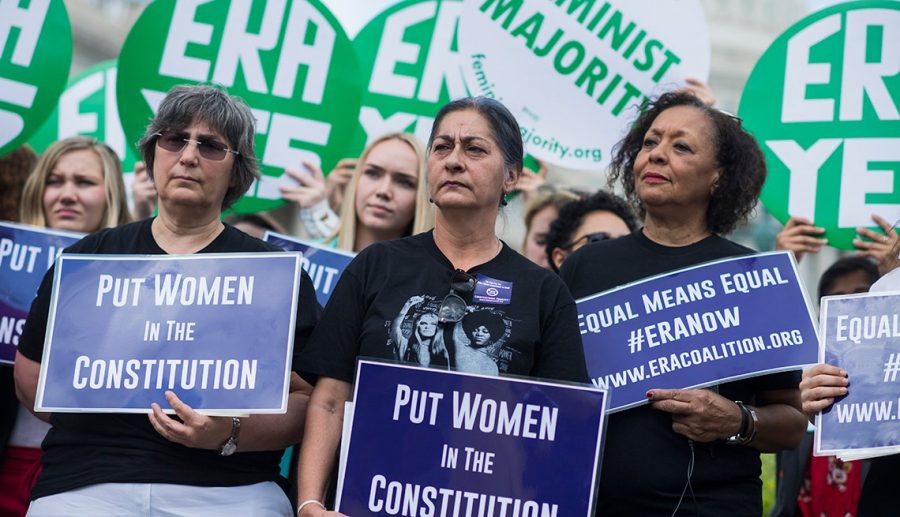The Equal Rights Amendment is necessary
Now more than ever, we need equal rights protections in writing
Women have been advocated for the ERA for decades
June 9, 2021
At the 2019 and 2020 State of the Union Addresses, Democratic Congresswomen wore suffragette white and ERA buttons. In 20201, women need to take it a step further.
Women currently face inequalities in multiple aspects of their lives. The impact of problems such as pregnancy discrimination, wage gaps and discrimination in the armed forces and government programs can be decreased and eventually eradicated. The Equal Rights Amendment, or the ERA, will not make all of these problems just vanish, but it will allow a large step in the right direction.
The ERA states:
“Section 1: Women shall have equal rights in the United States and every place subject to its jurisdiction. Equality of rights under the law shall not be denied or abridged by the United States or by any State on account of sex.
Section 2: Congress and the several States shall have the power to enforce, by appropriate legislation, the provisions of this article.
Section 3: This amendment shall take effect two years after the date of ratification.”
The ERA would allow protection against gender based discrimination, which is significant, because there is nothing in the Constitution explicitly stating equality between genders. Since the US Constitution has been adopted, it has protected the rights of white males. Although the interpretation of the Constitution has been altered through time and court decisions, the document under which our nation is governed remains without an amendment preventing discrimination on the basis of gender and sex. With the ERA, it will finally be stated, in writing, that women are equal among others in society.
Additionally, cases such as Glenn v. Brumby have ruled that discrimination against transgender people for being transgender is sex discrimination, and cases such as Hively v. Ivy Tech Community College of Indiana and Zarda v. Altitude Express, Inc. have ruled discrimination on the grounds of sexual orientation is also considered sex discrimination. The ERA does not just protect people from discrimination on the basis of gender, but also on other aspects of gender identity and gender regarded points.
Foundational aspects that make up who we are should not be used as reasons to discriminate against us.
In a AP-NORC poll conducted in January 2020 with 1,353 adults nationwide, “The impact for men in general [due to the passage of the ERA] is expected to be neither negative nor positive. Forty percent of women say the amendment would have a positive impact on them personally.” The ERA will not cause harm to anyone, but only bring women’s rights up to the level of men’s in society.
Not only this, but it will also help others who face gender inequality issues, even if they are not women. For example, had the ERA been in place, cases like Moritz v. Commissioner, in which Moritz was denied a caregiver deduction because he was male, there would have been a law explicitly overriding the court. Due to the foundation of our nation and the influence of society, we live in a world in which there are specific gender roles that we are expected to fill. We should not have to conform to society’s standards, and the ERA allows us to live our lives free of social influences.
According to a 2016 poll commissioned by the ERA Coalition, 94% of people polled support the amendment, but 80% polled already believed the Constitution already guaranteed equal rights. This goes to show that the fact that equal rights are not already guaranteed is so mind boggling that more than three quarters of people polled were not aware that it is not.
If women are said to be treated the same in society as everyone else, then the ERA will not make a difference. The passing of the ERA will only uphold and allow a law to point to when sexist injustices occur.
The Equal Rights Amendment is necessary to protect people from discrimination on the basis of sex, gender identity and sexual orientation.







